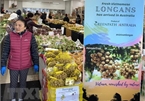The Plant Protection Department, under the Ministry of Agriculture and Rural Development, on December 17 noted that the Ministry of Agriculture, Forestry and Fisheries (MAFF) of Japan had written to the department declaring that Vietnam’s litchis can be exported to Japan.
The decision had resulted from five years of talks between the department and MAFF, alongside multiple experiments for food safety and quarantines.
Vietnam’s fresh litchis have made their way into several selective markets, including China, the United States, Australia, and the European Union.
In addition to granting the export license, the Japanese side set up a number of regulations on plant quarantines of Vietnamese litchi exports. The regulations came into force from December 15.
The quarantine requirements include growing litchis in monitored gardens that have been granted growing area codes by the Plant Protection Department; packaging and sterilizing litchis with methyl bromide; and attaching quarantine certificates to litchi batches being shipped to Japan.
The Plant Protection Department stated that it will continue to cooperate with local exporters and producers to promptly complete preparations and seek Japanese partners to ship the first batch of Vietnamese litchis from the 2020 crop.
Previously, Japan had opened its market to Vietnamese dragon fruit and mangos. SGT/VNA

China receives nearly three-quarters of Vietnam’s vegetable, fruit exports
China remained Vietnam’s largest importer of vegetables and fruits, accounting for 72.6% of Vietnam’s total export revenue from these products in the first five months of this year.

Long journey of Vietnamese fruits to Australia
Longan has become the fourth kind of Vietnamese fruit to be exported to Australia after litchi, mango and dragon fruit. However, experts say there is still a lot of work needed for Vietnam to secure a firm foothold in the market.
 Japan has announced it will become Vietnam’s new litchi buyer for the 2020 crop, Nguoi Lao Dong newspaper reported.
Japan has announced it will become Vietnam’s new litchi buyer for the 2020 crop, Nguoi Lao Dong newspaper reported.